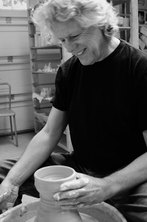
Like many western potters interested in Japanese esthetics and Buddhist philosophy, early on in my career I read The Unknown Craftsmen by Soetsu Yanagi. I was intrigued by his premise that the best works of art emerge from one's humble efforts, not from trying to create something extraordinary. In this spirit I thought that maybe I could turn pottery into a Do — a “path” or “way” -- in which I might practice mindfulness at the same time I make a living producing bowls and whatnot — a goal which, I think, might elude me forever.
In the early '90s, I began to study the Japanese Tea Ceremony, Chanoyu, with Dr. Shozo Sato, learning how Taoist and Buddhist philosophy is expressed in the simple act of serving tea. For each lesson, Dr. Sato would select a specific set of utensils that embodied the spirit of that particular occasion and season. The lessons, which included art, history, and philosophy, as well as what it meant to be a host or guest, have helped me understand a little bit more about what might make a better person, a better potter. As part of San Francisco's Asian Art Museum educational program, Dr. Sato commissioned some tea bowls to serve the audience a bit of matcha after Chanoyu demonstrations. This kind of generosity, so common for Dr. Sato, has always been an inspiration, and I am not the only one who has benefited from it. His encouragement and support has kept me going through many trials. I have written two articles for Ceramics Monthly documenting some of these trials as a working artist: Mud, Sweat, and Tears (Sept. 1999) documents my kiln blowing up and the lessons I inevitably learned from thatevent. Cobalt Blues (Nov. 2000), focuses on how an artist must keep to his/her vision, or pay the price of waning inspiring. After many years of selling through various local galleries, I now sell my work exclusively from my own home studio/gallery in Albion, CA. Here is page link for directions to the studio. |